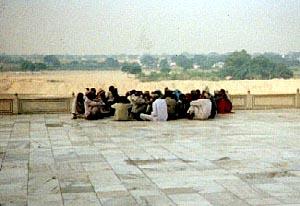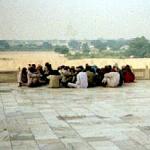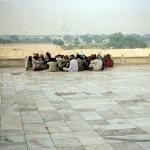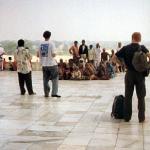Pardes
Near the 50th anniversary of India's 1947 independence appeared tricolor billboards advertising the Hindi film Pardes, or "foreign land", in this case America. The movie's theme song, "I love my India", became a smash hit.
In Pardes, a young woman from India (Mahima Chaudhury) is betrothed to an Americanized Indian. Though she prefers a native (heartthrob Shah Rukh Khan), she follows her fiance to America. Here she discovers his gallery of paramours and his rather severe alcoholism. Weeping, she telephones loved ones in India, saying, "Thik hu...khush hu." I'm fine...I'm happy.
Things go from bad to worst when her fiance tries to rape her. She manages to free herself, get rescued by Khan, and taken back to India. After a family struggle, involving Khan pulling a sword through his bloody fist as an act of devotion, Chaudhury is saved.
Pardes portrays India as a place of flowing fields and massive pastoral bungalows, overflowing with gentle familial love and play. America is portrayed as Las Vegas. At the film's beginning, a self-made Indian returning from America declares, "In America, love is give and take. In India, love is give, give, give."
As America becomes more Indianized and the world more Americanized, such comparisons are sure to increase. Being an American in India for six months, I was subjected to such comparisons and tendered a few myself. Most were half-baked and uninformed; nevertheless they had a value. After all, America and India are respectively the oldest and the largest democracies in the world.
Americans learn of India primarily through sanitized media or through travel. Unfortunately, Americans are notorious for sanitizing their travel as well:
"Americans know nothing.... They can't believe it when they find Coke in India; they think they're going into outer darkness, a place of disease, poverty, and squalor. Well, they are, but they never see it, so they go home thinking India is wonderful, from an air-conditioned coach, five-star hotels...." (In the Cities of the South: Scenes from a Developing World, Jeremy Seabrook, [Verso, London, 1996], 281).
To be fair, Indians are no more enlightened. An Indian colleague of mine expected us to be rowdy, our lives marred by violence and crime. "There is so much of theft and robbery!" speculated another. "Everyone can carry a gun!" Before visiting America, one friend likened it to The Bold and the Beautiful, the soap opera. This and other cultural relics -- I Love Lucy, I Dream of Jeannie, Bewitched, Baywatch -- are popular on Indian TV, India's primary source of misinformation. When I first visited classes at my school, I asked students if they had heard of America. Few hands went up. They were shy, but also uninformed. "That is where the fair people live," offered one.
One day an eager office worker approached me. He wanted to go to America, and wanted a few "points" to ease the transition. He wanted to know what made us so special. "America is trying to fix the world's problems and we can't even fix our own problems," he said. "We are trying to feed our people and America is sending people to Mars." Was there was something different about the American brain? he proposed.
Most Indians know America merely as a far-off place devouring their relatives. Few Indians I met were without family abroad. Mothers of sons schooled in the U.S. wrung their hands, as their sons' desire to return to India faded. Mothers gave me phone numbers and e-mail addresses, as though I could somehow mend their families.
Some students and teachers dreamt of emigrating. In an exercise in which students were supposed to finish the sentence "I wish that..." with ten different clauses, many wished to go to America. One teacher with poor English wished to work there but wondered if she were qualified. The school's computer-operator frowned whenever the e-mail connection went down. "This is India," he would say. "This is problem. Problem like this in America?" He spoke glowingly of Bill Gates; he saw movies like Men in Black, Lost World. He too admired the American brain. "Very good," he would say, tapping his temples. Outside the American Embassy, scores of Indians stood in line to apply for visas. There had been talk of abolishing the line. "It is humiliating," said a colleague.
Some of my Indian friends had traveled to America. Their reactions were mixed. Returned from a month-long visit in California, one effused, "That's one hell of a country you have there!" She proceeded to advertise America's conveniences. "Do you know that in America, if someone cleans your pool they clean it while you are away and then just leave a bill in the mailbox?" Explaining her added weight, she said, "You see, the food is not adulterated there as it is here." Before her journey, she had bemoaned the decay of values brought about by Westernization. She never did it again.
Others were not so enthusiastic. "Why would anyone want to live there?" asked a recent visitor to the East Coast. "I only like Indian food in India," she said, tapping her finger to emphasize the two words. She complained about prices. "To buy a pen in America is 2 dollars! You get a pen in India for 2 rupees!" Another said, "The standard of living in America is too high."
Still, some of their media-fed preconceptions were exploded. The same friend identifying America with The Bold and the Beautiful saw Americans with their families, pushing strollers, watching ball games, playing in parks. She found them polite, deferential - except in New York, where she found them cold.
In New York she saw traffic halted for a procession of Indians, a puja. They needed to get a permit for a puja! she complained. I protested, "But otherwise traffic will get all screwed up." Processions in India arise spontaneously. Scores of men board a transport truck, launch it out into traffic, drape a sign over the side, get a megaphone, and the procession has begun -- traffic be damned. To her, the unhindered freedom to have the procession was more important than order. My education was just beginning.
Long lines at the American embassy notwithstanding, a resounding 90+% of Indians would be born Indians again, according to an India Today poll. "I can't imagine living somewhere else besides Bombay," a teacher told me. "I don't understand leaving one's country," said another, whose brother had moved to Moscow to work. When teachers learned that my American colleague and I were living alone in our flat, they were concerned: "You must get lonely, na?"
My Indian colleagues maintained a healthy skepticism of the American way of life. America's treatment of the elderly, for example, they described as inhumane. Viewing the American work ethic for the first time, they were less awed than concerned. "Why do you look so worried?" they asked. "You are overworked." "You are not having tea?" "We think all Americans are sad."
One friend inquired into my religion. Herself a Catholic, she assumed I was Catholic. "I don't really have a religion," I said. She assumed that most Americans were Christian. "No," I corrected her. "Our religion is..." "Materialism," she said. But the invasion of India by American materialism is well underway. Pepsi and Coke vie with the indigenous Thums Up for top soft drink, but the race is moot: Thums Up was long ago bought out by the Coca-Cola company. In Bombay, Marlboros can be found at almost any paan and bidi shop. Domino's Pizza has appeared. The number of McDonald's in Bombay had grown to three. Kellogg's breakfast cereals spill out from the general stores. The shop-owner may have to dig a little, but he'll find Jif peanut butter and Vermont maple syrup.
American culture invades likewise. English films - meaning Hollywood films - are as numerous as Bollywood's. Though the latter are more popular, the former are enjoyed for their technical superiority. American television shows and music swamp the airwaves.
Dance clubs are sprouting up all over Bombay. The Copa Cabanna on Chowpatty Seaface is thronged with Indian starlets attending to persistent cell phones. Three Flights Up is a celebration of strobe lights. A cafe's jukebox - "the only CD jukebox in Bombay!" - plays Def Leppard tunes and "Achy Breaky Heart".
A dance competition I attended was broken up into "folk", "modern", and "Western" dance. The vacuity of the latter two was disturbing. Their moves were limited to a few recycled and repeated spasms, and each was accompanied by a small variation on the same doleful downbeat. Compared to the Keralan dances' lively grace, and the symbolic moves of bharatnatyam, these dances were an abomination. After the sparkling, colorful, elaborate outfits of the folk dancers, the Western dancers, donning only white and black, appeared to be in mourning.
Hybrids of Western and Indian culture can be still more disturbing, like the sari go-go bar. One such I unwittingly entered: the Cafi Cannon on Chowpatty Seaface. The eyes of its concierge lit up as my friend and I entered. We were led up shiny stairs to a low-ceilinged, little room lit by disco balls. At its center were dancing several young girls, wearing saris. Along the room's perimeter were couches separated from the dance floor by a chrome bar. In the couches sat mostly middle-aged, smiling Indian men sucking down beers and peanuts. Occasionally one would offer a Rs. 10 bill to a girl. Presently a waiter appeared with a roll of taped rupees, which a girl unfurled and draped around her neck.
Besides go-go bars, Westernization takes other forms. Westernized youth wear blue jeans, USA T-shirts and caps, stylish sunglasses; they wear skirts instead of salwar kameezes. They speak English with Hindi interjections, or vice versa - especially popular is the word "shit." They shop more, drink more, smoke more*; most of all, they walk and talk with an arrogant air lacking in my un-Westernized students.
Westernization takes other, more heartwarming forms, especially with regard to the elevation of the status of women. Divorces and "love-marriages" (marriages that are not arranged) are on the rise. Women's domestic and political voices grow louder.
This may, however, have unpalatable consequences. The Indian family is as cohesive as the American family is fragmented. I was reminded of this during my time in Bombay by watching a movie set in America. It was a typical Hollywood inanity - Liar, Liar starring Jim Carry. Forgive me - I was starved for Western culture.
The film has one discernible premise and lots of slapstick. Yet it was as culturally instructive as Pardes. The film's setting was the sterile American suburbs: minivan, identical house, perfect lawn, 9 to 5 job. Everybody seemed to be an adulterer or divorced -- except, of course, the woefully insecure children. The boy's bottom lip quivers as he learns that his father (who lives elsewhere in any case) is tied-up at the office and will miss his son's birthday once again.
Most unnerving was the aura of normalcy surrounding these abnormalities. In India, families do everything together. Divorce still carries a stigma. A travel writer spending time among nomadic peoples of northern India attributed Indian poise and self-assurance to the treatment of newborns: they are passed from one smiling person to another; they are held close and tight.
Many people in my generation have, like the boy in Liar, Liar, set their lips a-quiver because of neglect. Before coming to India, this scene would not have upset me. In India, it did. I began to understand the anti-Americanism of Indian movies like Pardes. I began to fear and loathe America myself.
* * * * *
Notes:
*Drinking may not sound so foreign as it should: prohibition was written into India's constitution as a concession to abstinent Gandhi; to drink in Maharashtra one nominally needed a permit; to drink in nearby Gujurat was banned outright. As for smoking, one scene in Pardes shows Chaudhury throwing a pack of Marlboros away with histrionic disgust.
* * * * *
 ThingsAsian
ThingsAsian


















